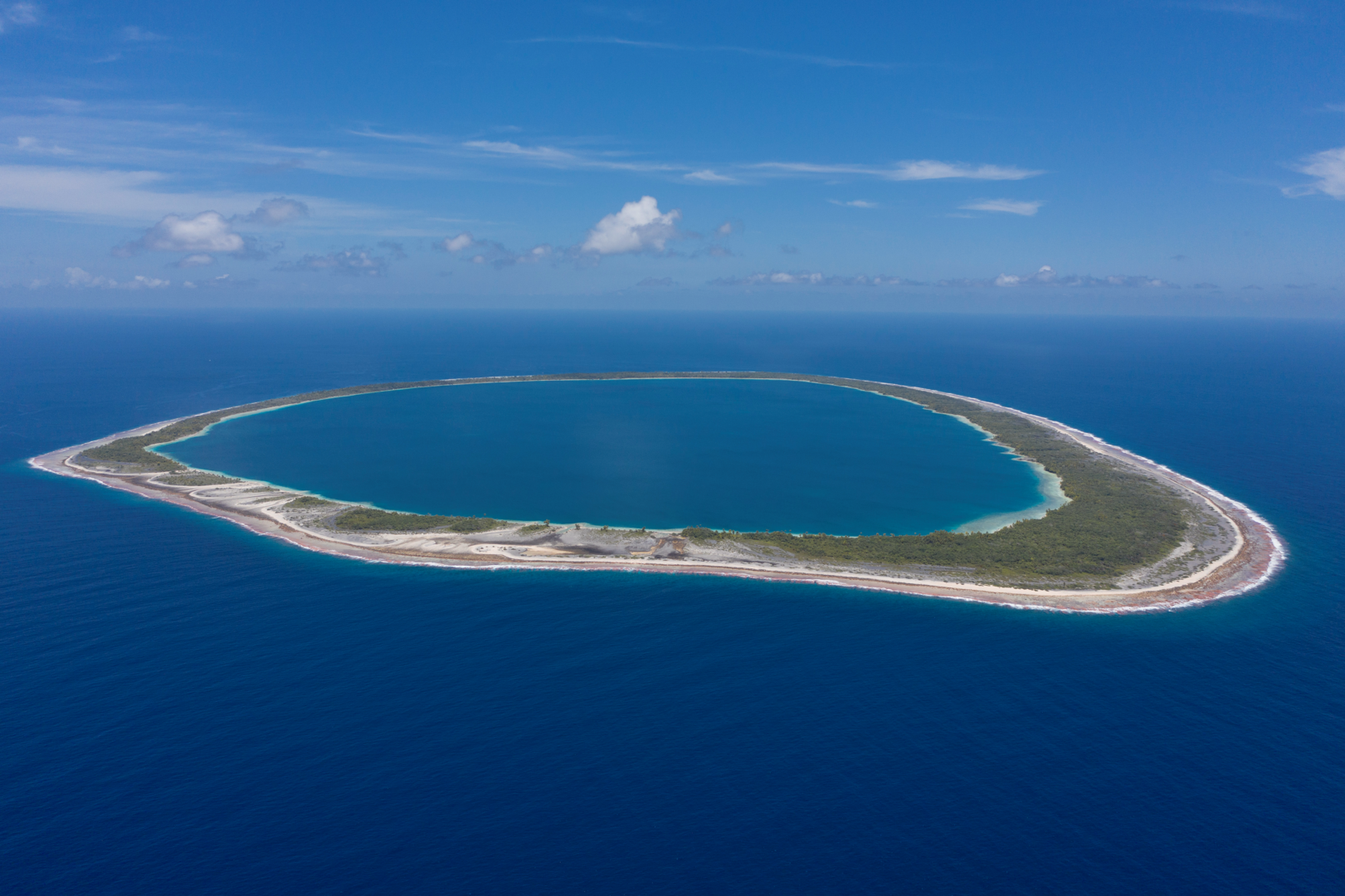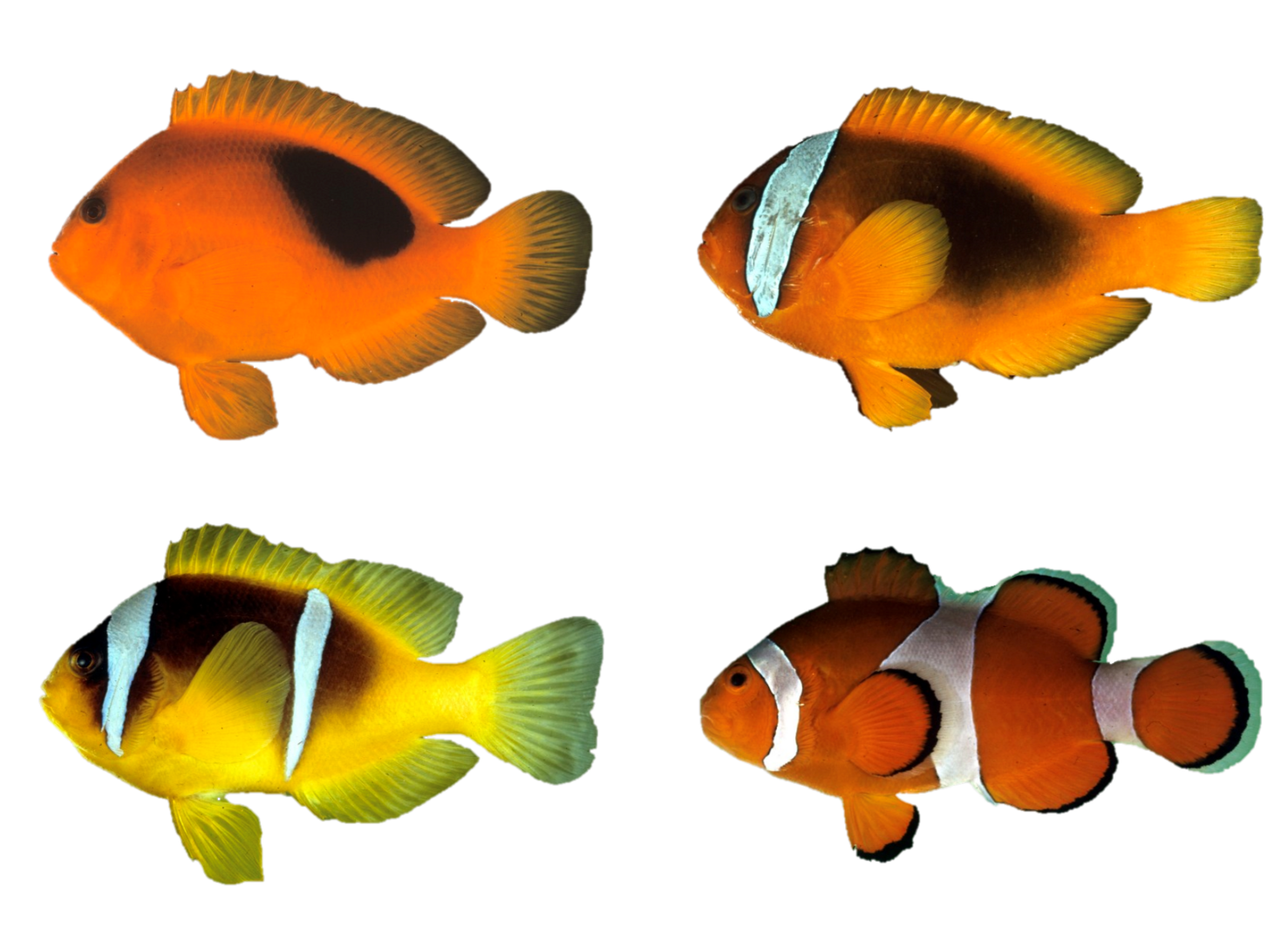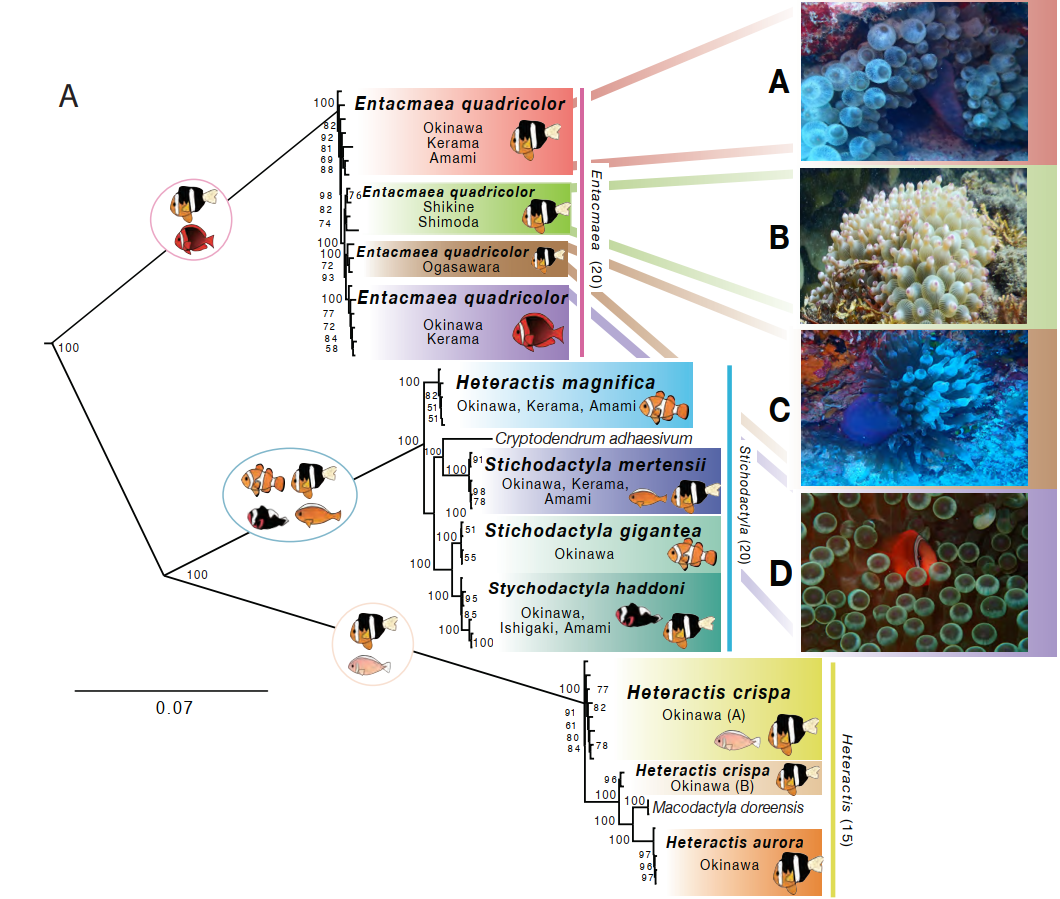FY2022 Annual Report
Marine Eco-Evo-Devo Unit
Professor Vincent Laudet

Abstract
The Marine Eco-Evo-Devo Unit uses coral reef fishes as model systems to study the ecology, evolution and developmental biology of complex traits. Using anemonefish we analyze the function, development and evolution of color patterns that occurred during metamorphosis and how environment acting on hormonal pathways change those patterns. Using surgeonfish or damselfishes we aim in understanding the mechanisms that allow local adaptation of fish populations in various coastal environments.
The unit is located into two sites: OIST of course in which the majority of unit members are located but also the Yilan Marine Research Station of the Institute of Cellular and Organismic Biology (ICOB) of Academia Sinica in Taiwan in which we benefit from a unique husbandry system and a great Evo/Devo environments. In addition we have long term established collaboration with the Oceanological Observatory of Banyuls-sur-Mer in France and the Centre for Island Research and Environmental Observatory (CRIOBE) in Moorea, French Polynesia with we organized field trips in remote atoll in the Pacific Ocean.
1. Staff
- Dr. Marleen Klann, Staff Scientist
- Dr Ken Maeda, Staff Scientist
- Dr Manon Mercader, Postdoctoral Scholar
- Dr Marcela Herrera Sarrias, Postdoctoral Scholar
- Dr Saori Miura, Lab Manager
- Dr Kina Hayashi, Research Fellow
- Dr Laurie Mitchell, Research Fellow
- Hiroki Takamiyagi, Fieldwork Technician
- James Hutasoit, Research Assistant
- Mathieu Reynaud, Special Research Student
- Emma Gairin, PhD Student
- Jann Zwahlen, PhD Student
- Yuki Tara, PhD Student
- Rio Kashimoto, PhD Student
- Agneesh Barua, PhD Student
- Noah Locke, PhD Student
2. Collaborations
2.1 A collaborative team to study a unique remote and closed atoll.
- The Taiaro Atoll in French Polynesia is a unique environment. Unlike other atolls where the inner lagoon is connected to the open ocean, the Taiaro atoll is fully closed. As a result, water the conditions inside the lagoon are very different from the surrounding oceanic water; temperature and salinity are significantly higher in the lagoon compared to the open ocean. Yet in the lagoon, there is a rich biodiversity including several fish species. Among these, a surgeonfish (manini) and butterflyfish are of particular interest as they are both present inside and outside the lagoon and population differentiation at the genetic level has been observed. The latter raises the questions as to what the genomic basis of such local adaptation are and how is the environment shaping the genotype and phenotype of these species. To answer this, we lead a scientific expedition to the Taiaro atoll with scientists from the Centre for Island Research and Environmental Observatory (CRIOBE) in Moorea, French Polynesia) as well as from the Banyuls Oceanologic Observatory (OOB, Banyuls-sur-Mer, France) and collect individuals from both environments. We also sample fish from different developmental stages to better understand their life cycle in the lagoon. Furthermore, we deployed instrumented buoys and other sensors developed by the Tenum company in collaboration with OOB to monitor temperature, salinity, ecosystem productivity, and the possible exchange of oceanic water with the lagoon. Changes in biodiversity, mainly fish and coral, and the physical environment of the lagoon, have also been assessed and compared to what it has been reported since the last surveys in 1994. The Taiaro atoll offer a unique environment to study in natural conditions, how fish population adapt to an environment that could be the one of the end of this century. This is therefore a unique laboratory for studying how fish will cope with climate change.
- Type of Research: Joint Research
- Reseachers:
- Prof. David Lecchini, CRIOBE
- Dr Serge Planes, CRIOBE
- Dr Renaud Vuillemin, OOB
- Dr Mireille Pujo-Pay, OOB
- Dr. Marcela Herrera Sarrias, OIST Laudet Unit
- Prof. Vincent Laudet, OIST Laudet Unit

A drone view of the Taiaro atoll (photo credit: Pascal Kobeh)
2.2 Ecological types of anemonefish
-
Understanding the reason why there is such a wide diversity of species is a major goal in evolution. Anemonefishes are a group of 28 species within the damselfish. Their obligate mutualism with giant sea anemones made them iconic species of coral reefs and is considered the driver of their adaptative radiation; different anemonefish species evolved convergent phenotypes correlated with their ecological niche. Up to now, differences between anemonefish species are mainly seen as diverging between generalist (able to live in any sea anemones) and specialist (living in only one or two sea anemone species). It is hypothesized that big generalist species would be better swimmers and more planktivorous than small specialist species. However, this has never been tested. We used an interdisciplinary approach to elucidate if anemonefishes' swimming capacities differ according to their general morphology and niche. We first recorded six species of anemonefish in the wild and found differences in their swimming behavior; some species spent most of their time outside the anemone, while others never ventured away from their host. However, those differences did not relate to the number of hosts. We then measured the critical swimming speed for the same species and surprisingly found no significant differences. We, however, found differences in the amount of energy needed to achieve the critical speed. To investigate what could cause those differences, we estimate muscle volume and reconstruct the outer shape of the fish. Finally, water flow around the fish was modelized by Stefano Olivieri in Marco Rosti unit to get insight in how the shape might affect how the fish swims and the associated cost of transport. From this we concluded that we can define several ecological types that on which we can allocate each of the 28 species of anemonefish existing in the indo-pacific area..
- Type of collaboration: Joint research
- Researchers:
- Professor Marco Rosti, OIST
- Dr. Manon Mercader, post-doc, Laudet unit
- Dr. Stefano Olivieri, post-doc, Rosti unit
- Shinya Komoto OIST imaging section microCT Scan
3D image of the clownfish Amphiprion ocellaris that allow to modelise the water flow around the fish during swimming
3. Activities and Findings
3.1 The multi-level regulation of clownfish metamorphosis by thyroid hormones
These hormones not only trigger but also coordinate the transformation of the larva into a juvenile at the tissue and cellular level. In addition, several reports suggest that the successful completion of metamorphosis is decisive for the quality, and therefore the ecological success, of the juvenile emanating from it. Therefore, understanding how thyroid hormones orchestrate this transformation is critical to better understanding the pleiotropic action of these hormones and how they allow juveniles to adjust to their new environment.
To gain insight into this question, we performed an integrated analysis of metamorphosis of a marine teleost, the false clownfish Amphiprion ocellaris by combining transcriptomics, thyroid hormones levels measurements, behavioral observations, lipid analysis, in situ observations, and functional experiments. We reveal how thyroid hormones coordinate a change in color vision as well as a major metabolic shift in energy production and fatty acid use, hence highlighting how it orchestrates this transformation. By manipulating the activity of LXR, a major regulator of metabolism, we also reveal a tight link between metabolic changes and metamorphosis progression. Strikingly, we observed that these regulations are at play in the wild, revealing how hormones coordinate energy needs with available resources during life cycle. Our results demonstrated that thyroid hormones link metabolic regulation, morphological transformation and behavioral changes ensuring the full ecological transformation of the pelagic larvae into a benthic reef associated juvenile.

How thyroid hormones (TH) are orchestrating the transformation of a pelagic anemonefish larvae living in the ocean into a young juveniles associated with a sea anemone
3.2 The function of white bars in anemonefish
Color patterns in coral reef fish are extraordinarily diverse and have a clear ecological and behavioral significance, with a wide range of functions that go from attracting mates to deterring predators. This is well exemplified by anemonefish that have distinctive color pattern with 0 to 3 vertical white bars on a black, red, orange, or yellow background. The number and shape of white bars differs among anemonefish species and previous analysis have suggested that white bars can be used for species recognition, a very important feature for anemonefish that often compete for the giant sea anemones with which they form mutualistic symbiosis. Other hypotheses have been suggested. For example, it has been suggested that white bars are disruptive and function to hide the fish silhouette. Other researchers proposed an aposematism hypothesis according to which the conspicuous color patterns serve to advertise the toxicity of the host anemone. Understanding the rules of species recognition is therefore critical to understand the mechanisms of colony formation and coexistence of multiple species within the host.
To gain insight into this question, Kina Hayashi performed behavioral experiments. She took advantageof the fact that the host anemone is used not only by the anemonefish, but also by other fish species that use anemones as temporary shelters. She first observed that there were no fish with bars sheltering in host anemones, although many fish with bars were found in surrounding corals. Next, she used fish models, one with white bars and the other with white stripes on a black background and she observed that the duration of aggressive behaviour towards the bar model was significantly longer than that towards the stripe model. More recentky she also found found that Amphiprion ocellaris hatched and reared in aquaria, when faced with an intruder fish, attacked their own species more frequently than other species of intruding anemonefish. Our findings support the hypothesis that clownfish are able to recognize and differentiate between conspecifics and other species (an ability that is critical to maintain their social structure) based on the number of vertical white bars. These findings pave the way for further studies to understand the cognitive basis of this elaborate behavioral ability.

An example of different color patterns in anemonefish From top left until bottom right: Amphiprion ephippium, A frenatus, A. bicinctus, and A. ocellaris (credit P. Salis and V. laudet)
3.3 Larval study revealed diversity and life history of crypto-benthic gobies
We identified larvae of five eel-goby species collected on Okinawa Island and their morphologies were described for the first time. The eel goby is one of the cryptic goby taxa of which adults are not easy to be located as they inhabits burrows on muddy bottom. The genus Trypauchenopsis was previously thought to consist of only one species, but our larval collection identified two species. We also reported the third specimen of a very rare species, Taenioides kentalleni, in the world. Although adult eel gobies inhabit a unique environment and have a strange appearance (reduced eyes and less pigmented, elongated body), their larval morphology is normal and they share their larval habitat with many other fish. Based on occurrence patterns and otolith analysis, the life history traits of the eel gobies (spawning season, pelagic larval duration, size at settlement, etc.) were reported. Our work reveals that studying the larval stage can provide new information on the taxonomy and life history of the elusive cryptobenthic fish.

Pelagic larva (top), transition stage larva (middle), and adult (bottom) of Trypauchenopsis limicola.
3.4 Transcriptomes of Giant Sea Anemones from Okinawa as a Tool for Understanding Their Phylogeny and Symbiotic Relationships with Anemonefish
The symbiosis between giant sea anemones, photosynthetic algae of the family Symbiodiniaceae, and anemonefish is an iconic example of a mutualistic “menage à 3”. Patterns of associations among 28 species of anemonefish and 10 species of giant sea anemone hosts are complex: Some anemonefish species are highly specialized to inhabit only one species of sea anemone (e.g., Amphiprion frenatus with Entacmaea quadricolor), whereas others are more generalist and can live in almost any host species (e.g., Amphiprion clarkii). Reasons for host preferences and the mechanisms involved are obscured, among other things, by the lack of resolution of giant sea anemone phylogeny. Recent molecular analyses have shown that giant sea anemones hosting anemonefish belong to three distinct clades: Entacmaea, Stichodactyla, and Heteractis. Inside these clades, however, species delimitation has been impeded by morphological variability of the giant sea anemones and is poorly resolved with classical markers. In our research, we generated an extensive transcriptomic dataset from 55 sea anemones collected from anemonefish habitat in Japan (Okinawa main island, Ishigaki, Kerama, Amami (Kagoshima) Shimoda (Shizuoka), Shikine and Ogasawara (Tokyo)) to build a robust phylogeny. With this dataset, we observed that the bubble-tip sea anemone E. quadricolor, currently considered to be a single species, can in fact be separated into at least four distinct cryptic lineages (A-D). Moreover, these lineages can be precisely distinguished by their association with anemonefish: A. frenatus is only found associated with lineage D, whereas A. clarkii lives in the other three lineages.
Now it will be important to clarify whether any morphological synapomorphies are associated with the various lineages and how these impact the symbioses. Also, it must be determined who is the driver of the detected divergences: is it the anemonefish that induces speciation or is it sea anemone that adapts to different species of fish? Also, our results implies that the classical describing the specific relationships between the anemonefish and their host should be revisited. It is striking that these two fish species can recognize distinct lineages that taxonomists have not been able to clearly separate until now. In this sense, anemonefish appear to be better ‘taxonomists’ than humans.

ML topology obtained using the supermatrix and a best-fit partitioning scheme in IQ-TREE
4. Publications
4.1 Journals
- Billy Moore, Marcela Herrera, Emma Gairin, Chengze Li, Saori Miura, Jeffrey Jolly, Manon Mercader, Michael Izumiyama, Erina Kawai, Timothy Ravasi, Vincent Laudet, Taewoo Ryu. The chromosome-scale genome assembly of the yellowtail clownfish Amphiprion clarkii provides insights into the melanic pigmentation of anemonefish, G3: Genes, Genomes, Genetics 13 (3), doi:10.1093/g3journal/jkad002
- Marcela Herrera, Timothy Ravasi, Vincent Laudet. Anemonefishes: A model system for evolutionary genomics, F1000Research 12 (204) doi: 10.12688/f1000research.130752.1
- Fedor Shkil, Daria Kapitanova, Vasily Borisov, Nikolay Veretennikov, Natacha Roux, Vincent Laudet, Direct development of the catfish pectoral fin: An alternative pectoral fin pattern of teleosts, Developmental Dynamics 251 (11), doi: 10.1002/dvdy.509
- Kina Hayashi, Katsunori Tachihara, James Davis Reimer, Vincent Laudet. Colour patterns influence symbiosis and competition in the anemonefish–host anemone symbiosis system, Proceedings of the Royal Society B 289 (1984), doi: 10.1098/rspb.2022.1576
- Rio Kashimoto, Miyako Tanimoto, Saori Miura, Noriyuki Satoh, Vincent Laudet, Konstantin Khalturin. Transcriptomes of Giant Sea Anemones from Okinawa as a Tool for Understanding Their Phylogeny and Symbiotic Relationships with Anemonefish. Zoological Science 39(4), doi: 10.2108/zs210111
- Taewoo Ryu, Marcela Herrera, Billy Moore, Michael Izumiyama, Erina Kawai, Vincent Laudet, Timothy Ravasi. A chromosome-scale genome assembly of the false clownfish, Amphiprion ocellaris, G3: Genes, Genomes, Genetics 13 (3), doi:10.1093/g3journal/jkac074
- Ken Maeda, Nozomi Hanahara, Masato Uehara, Katsunori Tachihara. Larval study revealed diversity and life-history traits of crypto-benthic eel gobies, Journal of Fish Biology 101 (6), doi:10.1111/jfb.15209
- Taiga Kunishima, Herminie P. Palla, Katsunori Tachihara, Ken Maeda. First Records of an Estuarine Goby Acentrogobius ocyurus (Gobiiformes: Gobiidae) from Japan and the Sulu Sea in the Philippines, Species Diversity 28(1), doi: 10.12782/specdiv.27.129
4.2 Books and other one-time publications
- Vincent Laudet and Timothy Ravasi, ed., Evolution, Development and Ecology of Anemonefishes: Model Organisms for Marine Science, CRC Press (Boca Raton), doi: 10.1201/9781003125365
- Natacha Roux, David Lecchini, Vincent Laudet, The Post-Embryonic Period of Anemonefishes
- Color Patterns in Anemonefish
- Habitat Selection of Anemonefish
- The Impact of Popular Film on the Conservation of Iconic Species
- 前田健 (Ken Maeda), 第5章 赤いボウズハゼの謎. 島野智之・脇司(編)新種発見物語 足元から深海まで11人の研究者が行く! 岩波書店発行 Chapter 5, Mystery of red gobies. In Shimano S. and Waki T. (eds) New species stories. (publisher: Iwanami Shoten)
4.3 Oral and Poster Presentations
- Agneesh Barua, The evolutionary genetics of venoms: How nature created the perfect chemical weapon, July 2022, SMBE Everywhere - virtual Global Symposium.
- 林 希奈、Laudet Vincent, カクレクマノミ未成魚の攻撃行動に影響する白帯本数, September 2022,
- 前田健 (Ken Maeda), 沖縄の川の魚の多様性(沖縄生物教育研究会創立70周年記念講演会, September 2022, Diversity of freshwater and estuarine fish in Okinawa (Commemorative Lecture for the 70th anniversary ceremony of the Okinawa Biology
- 小林大純・前田健・白井厚太朗・飯田碧・山平寿智 (Hirozumi Kobayashi, Ken Maeda, Kotaro Shirai, Midori Iida, and Kazunori Yamahira), ノコギリハゼ科ジャノメハゼ属の分類学的再検討および洞窟性種の系統・回遊様式(日本魚類学会2022年度年会), September 2022, Taxonomic revision of the genus Bostrychus with the phylogenetic position and migration ecology of B. microphthalmus (The 56th Annual Meeting of the Ichthyological Society of Japan)
- 是枝伶旺・前田健・本村浩之 (Reo Koreeda, Ken Maeda, and Hiroyuki Motomura), 河口域の伏流水中に生息するナガミミズハゼ種群の4未記載種の形態と分布状況(日本魚類学会2022年度年会), September 2022, Morphologies and distributions of four undescribed species in the Luciogobius elongatus complex from Japan, inhabiting underflow water in the river mouth (The 56th Annual Meeting of the Ichthyological Society of Japan)
- 前田健 (Ken Maeda), 海を渡る淡水魚(第38回 国際生物学賞記念シンポジウム "魚の生物学:その生態、進化と発生"), December 2022, Freshwater fishes coming across the ocean (Commemorative Symposium for the 38th International Prize for Biology “Biology of Fishes: Ecology, Evolution and Development”)
- 前田健・山崎曜 (Ken Maeda and Yo Yamasaki), ケンムンヒラヨシノボリとヤイマヒラヨシノボリの卵サイズ(2022年度ゴリ研究会), February 2023, Egg sizes of Rhinogobius yonezawai and Rhinogobius yaima (GORI Research Meeting FY2022)
- 林 希奈, イソギンチャク・カクレクマノミの秘密を知ろう!(サイエンステックラボ:沖縄県委託事業 令和4年度子ども科学技術人材育成事業 生物コース), August 2022
- 林 希奈, クマノミ類の共存と競争に影響を与える色彩パターン(大阪公立大学 動物社会学研究会:招待講演), February 2023
- Marleen Klann, Color patterning in anemonefish, October 2022, INSB CNRS OIST visit (André Le Bivic-head of INSB, Emmanuel Brouillet- CNRS International and European service manager, Clément Depuis-CNRS International Cooperation Officer)
5. Intellectual Property Rights and Other Specific Achievements
Nothing to report
6. Meetings and Events
Seminar "Genomics of parallel speciation and adaptation in crater lake cichlid fishes"
- Date: August 10, 2022
- Venue: OIST Campus Lab4
- Speaker: Prof. Dr. Axel Meyer, Lehrstuhl für Zoologie und Evolutionsbiologie, Department of Biology, University of Konstanz
7. Other
Nothing to report.



